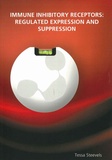Immune inhibitory receptors
Regulated expression and suppression

Steevels, Tessa
- Promoter:
- Prof.dr L. (Linde) Meyaard & prof.dr P.J. (Paul) Coffer
- Research group:
- Coffer
- Date:
- January 20, 2011
- Time:
- 10:30 h
Summary
The immune system protects against disease by identifying and eliminating pathogens, while leaving healthy host cells unaffected. Regulatory mechanisms are required to prevent excess or inappropriate immune cell activation and to ultimately terminate the immune response, thereby restoring homeostasis. One important regulatory mechanism is the expression of immune inhibitory receptors, which suppress activation signals initiated by immune receptors. Immune inhibitory receptors are characterized by the presence of Immunoreceptor Tyrosine-based Inhibitory Motifs (ITIMs) in the intracellular tail of the receptor, which are crucial for the inhibitory function. Further research on inhibitory receptors is essential to fully understand their distinct roles in infection or inflammation and during the various stages of the immune response. This thesis centers on the characterization and function of the novel immune inhibitory receptor termed signal inhibitory receptor on leukocytes-1 (SIRL-1), and on the expression and function of the inhibitory receptor leukocyte-associated Ig-like receptor-1 (LAIR-1). Utilizing an in silico search for novel inhibitory receptors we identified SIRL-1. SIRL-1 contains two ITIMs and is exclusively expressed on human phagocytes. As a classical ITIM-bearing receptor, SIRL-1 is capable of inhibiting Fc?RI-mediated signaling and recruiting SH2 domain-containing phosphatases. The expression of SIRL-1 is regulated; pattern recognition receptor-induced phagocyte activation leads to a down-regulation of SIRL-1 expression. Furthermore, cross-linking of SIRL-1 decreases Reactive Oxygen Species (ROS) production in primary human phagocytes. ROS production by phagocytes is crucial for bacterial killing, and SIRL-1 cross-linking on primary neutrophils results in reduced killing of internalized bacteria. Notably, phagocytosis and cytokine production by phagocytes are not affected by SIRL-1 cross-linking, pointing to a selective regulation of ROS production. We propose that SIRL-1 on phagocytes sets an activation threshold to prevent inappropriate production of oxygen radicals. Upon infection, SIRL-1 is down-regulated, allowing microbial killing and clearance of the pathogen. Collagens are high affinity ligands for the inhibitory receptor LAIR-1, which is expressed on the majority of human peripheral blood mononuclear cells. The activating collagen receptor glycoprotein VI (GPVI) is structurally related to LAIR-1 and LAIR-1 cross-linking abrogates collagen-induced GPVI signaling when both receptors are ectopically expressed on the same cell. Interestingly, we identified a subset of morphologically distinct megakaryocytes which co-express GPVI and LAIR-1. We report for the first time that a primary cell co-expresses these collagen receptors with opposite signaling properties. Since megakaryocytes mature in the collagen-rich environment of the bone marrow, these findings may point to a role for LAIR-1 in the control of megakaryocyte migration. The most prominent splice variants of LAIR-1 are LAIR-1a and LAIR-1b, with LAIR-1b lacking 17 amino acids in the stalk region of the extracellular domain. We show that B and T cells express the LAIR-1b isoform, while granulocytes solely express LAIR-1a. We found that LAIR-1a has enhanced binding to collagen compared to LAIR-1b. Through its adhesive properties, LAIR-1a could affect neutrophil transmigration and perhaps megakaryocyte retention in the bone marrow niche. These hypotheses are subject of further investigation. Taken together, this thesis contributes to the understanding of the role of inhibitory receptors in immune regulation.